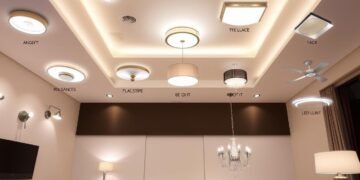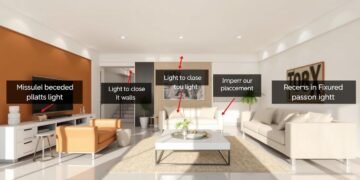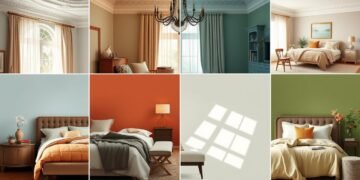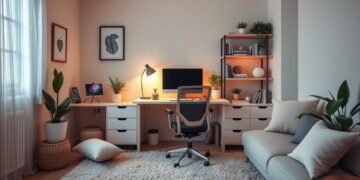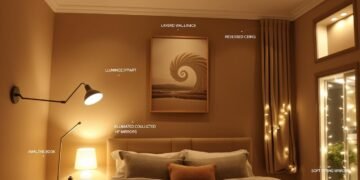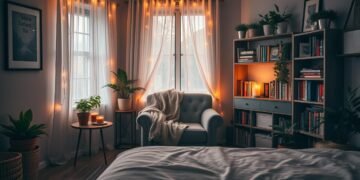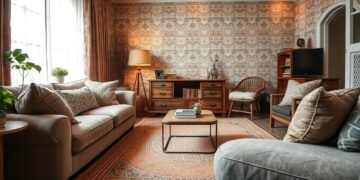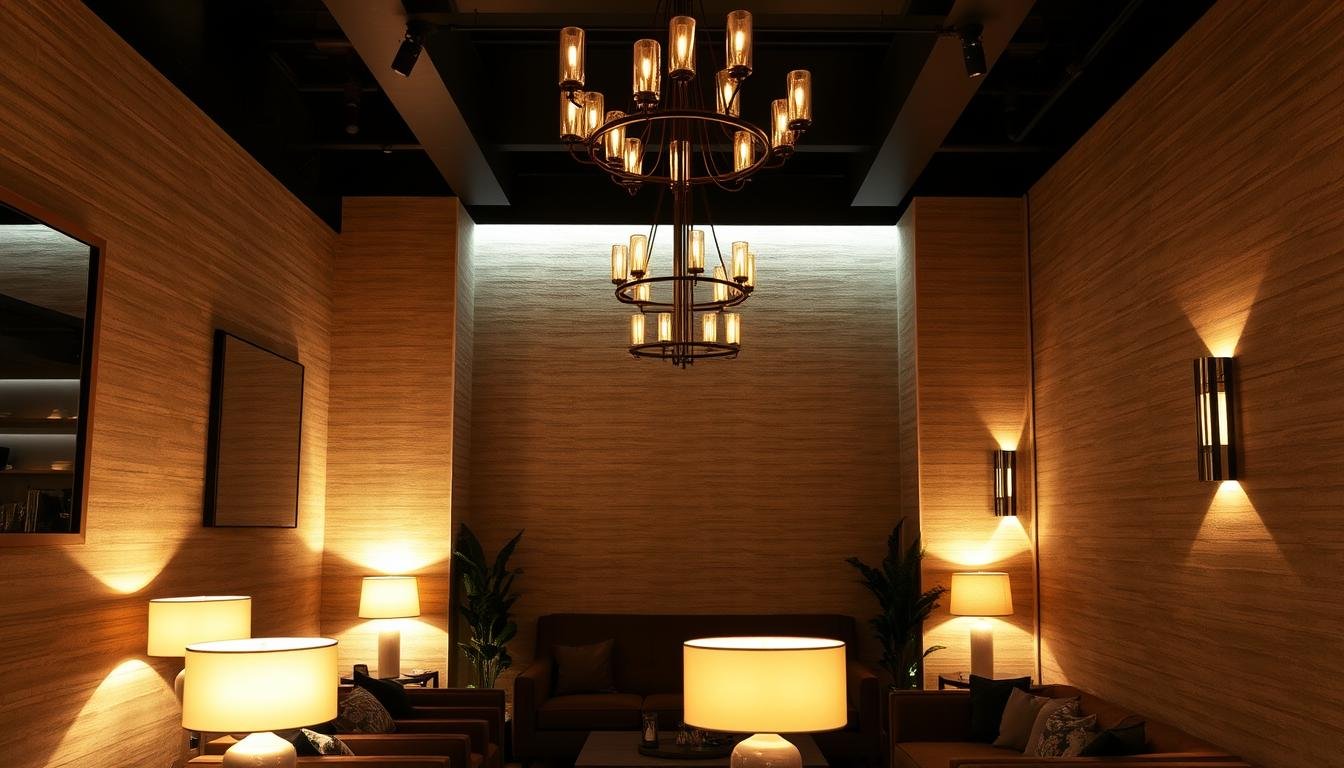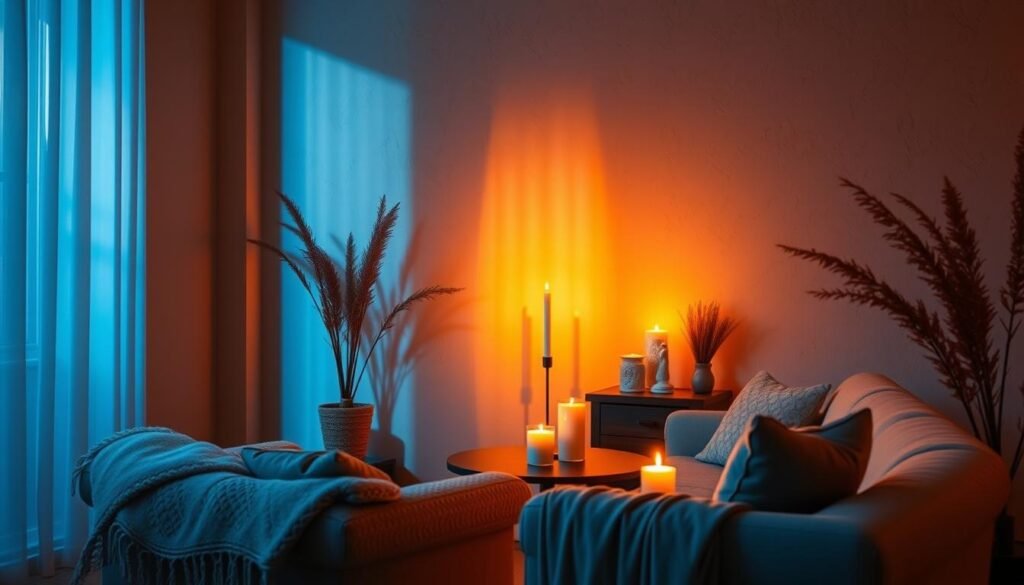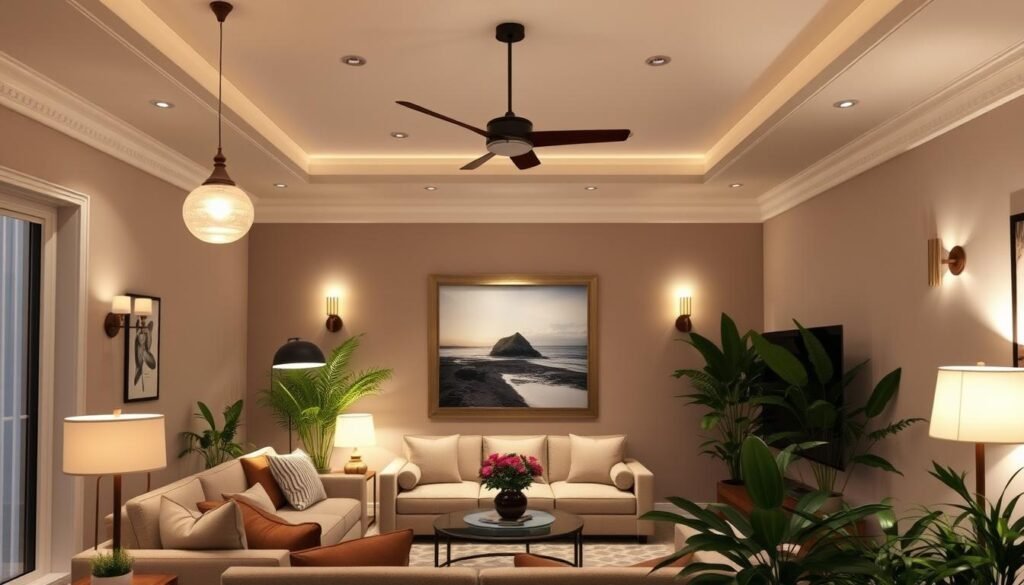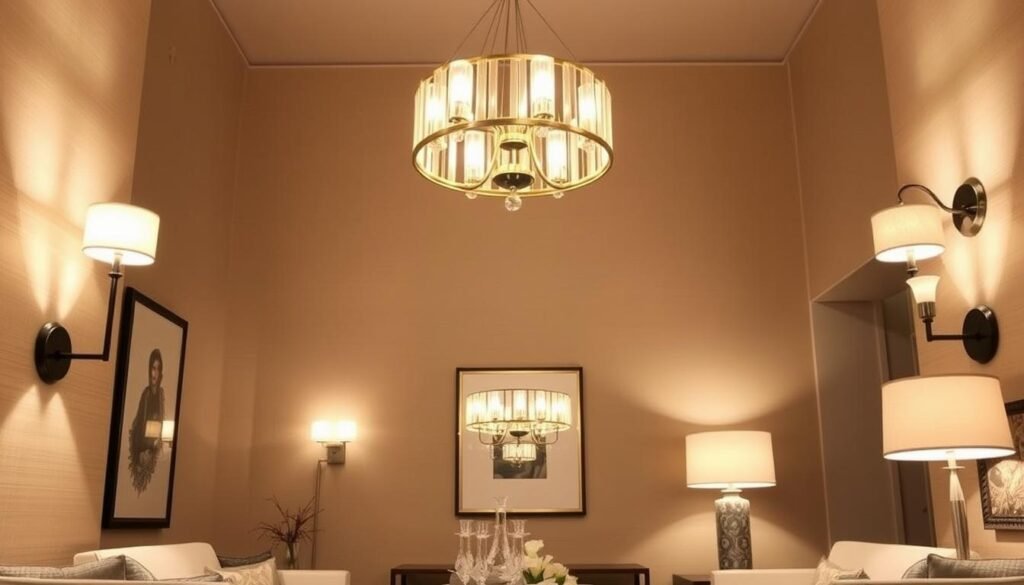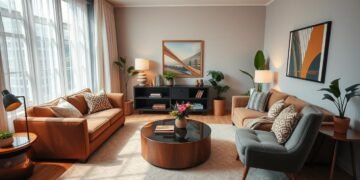Ever noticed how some rooms feel welcoming, while others seem cold? The key is in layering light, a smart lighting trick that makes any space special.
Interior designers know that light has three roles: ambient, task, and accent. These work together to change a room’s mood, function, and look.
Lighting isn’t just about seeing; it’s about feeling. The right lighting can make a room feel like your own, showing off your style and meeting your needs.
Table of Contents
- 1 Understanding the Fundamentals of Light Layering
- 2 The Power of Color Temperature in Creating Atmosphere
- 3 Smart Lighting Solutions for Enhanced Control
- 4 Layering Light in Interior Design
- 5 Strategic Placement of Light Sources
- 6 Natural Light Integration and Enhancement
- 7 Choosing the Right Fixtures for Different Layers
- 8 Balancing Light Intensity and Distribution
- 9 Conclusion
- 10 FAQ
- 10.1 What is light layering and why is it important in interior design?
- 10.2 How do the three types of lighting work together?
- 10.3 What role does color temperature play in lighting design?
- 10.4 How can smart lighting improve my home’s illumination?
- 10.5 What are some tips for strategically placing light sources?
- 10.6 How can I integrate natural light with artificial lighting?
- 10.7 What should I consider when selecting lighting fixtures?
- 10.8 How do I achieve the right balance of light intensity?
Key Takeaways
- Understand the three essential types of interior lighting
- Learn how to create depth and warmth through light layering
- Discover techniques for controlling light intensity
- Explore the psychological impact of different lighting approaches
- Master the art of highlighting room focal points
Understanding the Fundamentals of Light Layering
Creating the perfect lighting design is more than just turning on the lights. It’s about using different lighting types to add depth, function, and beauty to a room.
Professional designers know that good lighting has three main layers: ambient, task, and accent. Each layer has its own role in making a space welcoming and useful.
Ambient Lighting Basics
Ambient lighting is the base of any lighting plan. It provides even light all over the room, making it easy to see. Common sources include:
- Ceiling fixtures
- Chandeliers
- Recessed lighting
- Pendant lights
- Lighting panels
Task Lighting Essentials
Task lighting shines on specific areas, making them better for work or hobbies. It helps reduce eye fatigue and boosts performance.
- Desk lamps for home offices
- Under-cabinet kitchen lights
- Reading lamps
- Bathroom vanity lights
Accent Lighting Functions
Accent lighting brings out the best in a room by focusing on special features or art. Track lighting and wall sconces are great for creating eye-catching spots.
“Lighting is the jewelry of the home – it can transform an ordinary space into something extraordinary.”
When planning your lighting, keep these key points in mind:
- Balance light intensity across different layers
- Use multiple light sources at varying heights
- Select fixtures that complement your interior design
By understanding and using these lighting types, you can make a space that’s both beautiful and practical. It will meet your needs as they change.
The Power of Color Temperature in Creating Atmosphere
Lighting is more than just light. It’s an art that changes spaces and feelings. Color temperature is key in making the right mood and look in any room.
Knowing about color temperature lets you make the perfect atmosphere for any space. It’s measured in Kelvin (K), ranging from warm to cool. Each range gives a different feeling:
- Warm light (2000K-3000K): Creates a cozy, intimate feel perfect for living rooms and bedrooms
- Cool light (4000K-6500K): Generates an energetic, focused environment ideal for kitchens and workspaces
“Lighting is the jewelry of architecture – it adds sparkle and drama to any space.” – Interior Design Expert
Different rooms need different lighting. Here’s a quick guide to pick the right color temperature:
| Room | Recommended Color Temperature | Lighting Mood |
|---|---|---|
| Living Room | 2700K-3000K | Warm, Inviting |
| Kitchen | 3000K-4000K | Bright, Energetic |
| Bedroom | 2400K-2700K | Soft, Relaxing |
Pro tip: Smart bulbs now let you change color temperature anytime. This way, you can make the perfect mood for any moment or activity.
Smart Lighting Solutions for Enhanced Control
Modern home lighting has changed a lot with smart technologies. Now, homeowners can change their homes with new lighting that fits their life and taste.
Smart lighting is more than just light. It lets you customize and control your home’s lighting in new ways. These systems are great for both saving energy and being more efficient.
Smart Dimming Technologies
Dimmers have gotten smarter with smart lighting. Now, LED bulbs can be adjusted easily. This lets you set the mood for any moment. The benefits are:
- Precise light intensity control
- Energy savings up to 75% compared to traditional bulbs
- Extended bulb lifespan
- Customizable brightness levels
Automated Lighting Schedules
Smart lighting lets you set up schedules that make life easier and safer. You can:
- Make it look like someone’s home when you’re not
- Change lights based on the time of day
- Make your own lighting scenes
Mobile App Integration
Control your home’s lights from anywhere with mobile apps. These apps offer:
| Feature | Benefit |
|---|---|
| Remote Access | Control lights from smartphone |
| Scene Creation | Preset lighting configurations |
| Voice Control | Hands-free lighting management |
“Smart lighting transforms your home into an intelligent, responsive environment that adapts to your needs.” – Lighting Design Expert
Smart lighting lets you control your home’s lighting in new ways. It makes your home look better and work better too.
Layering Light in Interior Design
Interior lighting design is more than just lighting up a room. It’s an art that changes spaces by adding depth, mood, and function. This is done through smart lighting techniques.
Designers know that a good space needs many light sources. They aim to create a balanced area that fits different activities and times. This balance is key.
- Ambient lighting provides overall room illumination
- Task lighting supports specific activities
- Accent lighting highlights architectural features
- Decorative lighting adds aesthetic appeal
Getting the lighting right is essential for a harmonious space. Each light layer has its own role. Together, they make a space lively and welcoming.
“Effective lighting design is about creating an experience, not just visibility.”
Different rooms need their own lighting plans. Here are some expert tips:
| Room Type | Lighting Approach | Recommended Fixtures |
|---|---|---|
| Living Room | Multiple light sources | Floor lamps, table lamps, wall sconces |
| Kitchen | Task-focused lighting | Pendant lights, under-cabinet lighting |
| Bedroom | Soft, layered illumination | Bedside lamps, wall-mounted fixtures |
Pro tip: Accent lighting should be about three times stronger than ambient lighting. This creates stunning visual interest and depth in your spaces.
Strategic Placement of Light Sources
Mastering lighting placement is an art that turns ordinary spaces into amazing places. The right way to place light fixtures can greatly improve a room’s mood, function, and look.
Professional designers know that good lighting does more than just light up a room. It creates layers, depth, and interest with well-thought-out light sources.
Height Variation Techniques
Varying light fixture heights is key to making spaces lively and interesting. Here are some smart strategies:
- Install chandeliers at different heights to avoid visual boredom
- Use wall sconces at various levels to add depth
- Combine pendant lights with floor and table lamps for layered lighting
Room Zone Planning
Split your space into zones, each needing its own lighting. Here’s a simple way to do it:
| Room Zone | Recommended Light Fixtures | Purpose |
|---|---|---|
| Reading Area | Task Lamp | Focused illumination |
| Dining Space | Pendant Lights | Ambient and decorative |
| Work Corner | Adjustable Desk Lamp | Precise lighting |
Creating Focal Points
Accent lighting can make ordinary rooms stand out. Wall sconces and well-placed lights can highlight artwork, architectural details, or special decor.
“Lighting is the jewelry of interior design – it can make or break the entire aesthetic.” – Design Expert
Remember, strategic lighting placement is about making a space inviting and balanced. It should serve both function and beauty.
Natural Light Integration and Enhancement
Creating the perfect indoor environment starts with understanding natural light integration. Your home’s lighting design can transform spaces by combining natural light with artificial illumination.
Natural light is key in making spaces look and feel better. Smart lighting control strategies help use light reflection to create dynamic, energy-efficient environments.
- Utilize reflective surfaces to amplify natural light
- Select light-colored flooring to enhance brightness
- Install strategic window treatments
- Complement daylight with artificial lighting
“Lighting is not just about illumination, but about creating an experience that transforms your living space.” – Design Expert
Indirect lighting softens harsh sunlight and keeps the light consistent all day. Designers suggest layering different light sources for depth and interest.
| Lighting Technique | Benefits | Energy Efficiency |
|---|---|---|
| Window Placement | Maximizes natural light intake | High |
| Reflective Surfaces | Increases light distribution | Medium |
| Artificial Complement | Ensures consistent illumination | Moderate |
By blending natural and artificial light, you can make a space that’s both functional and mood-enhancing.
Choosing the Right Fixtures for Different Layers
Creating the perfect lighting design is all about picking the right light fixtures. They should light up your space and make it look great. Knowing how different fixtures work together can turn any room into something special.
Choosing the right fixtures is about finding the right mix of looks and function. Experts say to mix different lighting types to add depth and interest.
Decorative Lighting Options
Decorative light fixtures are like art pieces in your home. Here are some ideas:
- Chandeliers that make a big statement
- Unique table lamps with cool designs
- Floor lamps that match your room’s style
- Pendant lights with unique shapes and materials
Functional Fixture Selection
Practical lighting is key for a well-lit space. Led lights and under cabinet lighting are great for specific areas. Here are some practical options:
- Recessed lights for even lighting
- Under cabinet lighting for kitchens
- Task-specific floor lamps for reading
- Adjustable track lighting for flexible lighting
Style Coordination Tips
“The secret to great lighting is creating a harmonious visual symphony across different fixture types.”
Here are some tips for coordinating light fixtures:
- Keep metal finishes consistent
- Balance the look of different lights
- Mix styles but keep a theme
- Use dimmers for mood control
Remember, the goal is to create a layered lighting approach that combines functionality with aesthetic appeal.
Balancing Light Intensity and Distribution
Creating the perfect lighting environment is all about light intensity and distribution. Your space needs a lighting design that boosts both function and feel. Learning to mix direct and task lighting can turn any room into something special.
Lighting balance is more than just picking fixtures. It’s about creating layers that blend perfectly. Here are some key strategies for the best light distribution:
- Evaluate existing natural and artificial light brightness levels
- Implement dimmers for flexible atmosphere control
- Use a mix of ambient, task, and accent lighting
- Select fixtures that complement your space’s design
“Lighting is the jewelry of interior design – it can make or break the entire aesthetic.” – Design Experts
Managing light intensity involves these key techniques:
- Color Temperature Selection: Warm colors for homes, cool whites for work areas
- Create lighting zones with separate circuits
- Utilize LED bulbs for energy-efficient illumination
| Space Type | Recommended Color Temperature | Lighting Strategy |
|---|---|---|
| Living Room | Warm (2700-3000K) | Layered ambient and accent lighting |
| Home Office | Cool White (4000-5000K) | Task lighting with adjustable intensity |
| Bedroom | Soft Warm (2700K) | Dimmable ambient lighting |
By managing light intensity and distribution, you can make spaces that are both useful and beautiful. Smart lighting solutions give you control to customize your space easily.
Conclusion
Mastering layered lighting techniques can turn any room into a special place. It’s not just about light; it’s about making spaces that fit your life and mood. By mixing different light sources, you can make rooms that look great and work well.
Lighting psychology is key to how we feel in our homes. Ambient, task, and accent lighting add depth and mood. Good designers know it’s not just about how bright it is. It’s about feeling connected to your space. Brands like Wipro offer top LED tech for control and saving energy.
Each light layer has its own job. Ambient light sets the mood, task lighting helps with activities, and accent lighting shows off the room’s best features. Balancing these layers makes any room a lively, cozy spot that meets your needs all day.
Your lighting design is a chance to show your creativity and make your home better. With careful planning and the right lighting, you can make spaces that are full of life and purpose.




